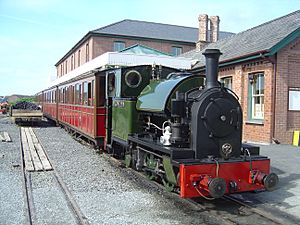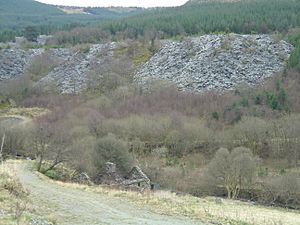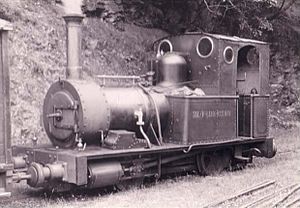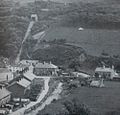Talyllyn Railway facts for kids
Quick facts for kids
Rheilffordd Talyllyn |
|
|---|---|
|
Locomotive No. 4 Edward Thomas stands at Tywyn Wharf station – April 2005
|
|
| Locale | Wales |
| Terminus | Tywyn Wharf |
 |
|
| Commercial operations | |
| Name | Talyllyn Railway |
| Original gauge | 27 |
| Preserved operations | |
| Operated by | Talyllyn Railway Company, supported by Talyllyn Railway Preservation Society |
| Stations | 7 and 5 halts |
| Length | 7.25 miles (11.67 km) |
| Preserved gauge | 27 |
| 1866 | Opened |
| 1911 | Sold to Henry Haydn Jones |
| 1946 | Quarry closed |
| Preservation history | |
| 1951 | Taken over by the Preservation Society |
| 1976 | Opening of extension to Nant Gwernol |
| 2001 | Railway celebrates 50 years of preservation |
| 2005 | New station building and museum opened at Tywyn |
The Talyllyn Railway (Welsh: Rheilffordd Talyllyn) is a special narrow-gauge train line in Wales. It is a "preserved" line, which means it has been saved and kept running for people to enjoy. The railway is about 7.25 miles (11.67 km) long. It goes from Tywyn[a] on the coast of Mid-Wales to Nant Gwernol. This station is close to the village of Abergynolwyn.
The line first opened in 1866. Its main job was to carry slate from the Bryn Eglwys quarries to Tywyn. It was the first narrow-gauge railway in Britain allowed by law to carry passengers using steam trains. Even though it didn't get much money for repairs, the line stayed open. In 1951, it became the first railway in the world to be saved by volunteers.
Since then, the railway has become a popular place for tourists. It has added more trains and carriages by buying and building them. In 1976, the line was made longer. It now goes from Abergynolwyn to the new station at Nant Gwernol. In 2001, the group that saved the railway celebrated its 50th birthday. In 2005, the Tywyn Wharf station was rebuilt and made much bigger. A larger Narrow Gauge Railway Museum was also opened there.
The famous fictional Skarloey Railway from the Railway Series books was based on the Talyllyn Railway. These children's books were written by The Rev. W. Awdry. Saving the Talyllyn Railway also inspired the movie The Titfield Thunderbolt.
Contents
What's in a Name?
The railway's name has a bit of a mystery. It might be named after the parish of Talyllyn. This area includes the end of the railway line. Or, it could be named after Tal-y-llyn.[b] This is a big lake about 3 miles (4.8 km) further east, at the foot of Cadair Idris mountain.
The railway's track is 2-foot-3-inch (686 mm) wide. This is a very unusual size. Only three other public railways in the United Kingdom shared this exact width. These included the nearby Corris Railway and later the Plynlimon and Hafan Tramway and Campbeltown and Machynlleth Light Railway.
Railway History
Building the Line: Before 1866
Slate mining started in the hills near Tywyn in the 1830s. Many small quarries were dug, but only one big quarry grew. This was at Bryn Eglwys, about 7 miles (11 km) north-east of Tywyn. Mining underground began in the early 1840s. By 1847, a local landowner named John Pughe was running the quarry.
The finished slates were carried by packhorse to a wharf at Pennal. From there, they went by boat down a river to Aberdyfi. Finally, they were loaded onto bigger ships. This way of moving slate was slow and costly. It limited how much slate the quarry could sell.
In 1861, the American Civil War began. This stopped cotton supplies to mills in England. Many rich mill owners looked for new businesses. One of them was William McConnel from Lancashire. In 1859, he bought a house near Dolgellau, north of Tywyn. In 1864, McConnel started the Aberdovey Slate Company. His company rented the land, including Bryn Eglwys, from Lewis Morris.
McConnel wanted to make Bryn Eglwys quarry better and produce more slate. In 1865, his company planned to build a narrow-gauge railway. It would connect the quarry to the port of Aberdyfi. But the Aberystwyth and Welsh Coast Railway was building a standard-gauge line quickly. By 1863, it had reached Tywyn. So, McConnel decided to build his railway from the quarry to Tywyn instead. This was the closest place to transfer slate to the standard-gauge railway.
A special law was passed on July 5, 1865. This law allowed McConnel's company to run passenger trains as a public railway. James Swinton Spooner was hired to design the railway. He planned a fairly straight line that would go up steadily from Tywyn to the quarry. Work started quickly. By September 1866, the railway was ready for an inspection.
The inspector, Captain Henry Tyler, found a problem. The railway's loading gauge was too small. This means the bridges were too narrow for the trains. The inside width of the bridges was only 9 ft 1 in (277 cm). But the passenger carriages were 5 ft 3.5 in (161.3 cm) wide. This left less than 2 ft (61 cm) of space on each side. The rule was that there should be at least 2 ft 6 in (76 cm) of space.
To fix this, McConnel suggested a clever idea. The doors on one side of each carriage would be closed forever. Also, the track would be moved slightly off-centre under the bridges. This would give enough space on the side with the doors. This way, passengers could still get out if the train stopped under a bridge. Tyler agreed. Even today, all Talyllyn carriages have doors on only one side. This is unusual for a public railway.
Tyler also asked for improvements to the first two steam locomotives. Locomotive No. 1 moved too much up and down. No. 2 moved too much side to side. No. 1 was sent back to the factory. It got extra wheels at the back to make it more stable. No. 2's springs were adjusted to stop its wobbling.
Early Success: 1866-1880s
The railway opened with two locomotives. One carried people, and the other carried goods. They used a "one engine in steam" rule. This meant only one train could be on the line at a time to prevent crashes. At first, the trains were kept in a wooden shed at Ty Dwr near Abergynolwyn station. The main repair workshop for the Talyllyn was being built at Pendre. This workshop opened on February 17, 1867.
When the Talyllyn Railway first opened, it had two stations: Pendre and Abergynolwyn. In 1867, the station at Rhydyronen opened. In 1873, Brynglas and Dolgoch stations also opened. Later, a line was built from Abergynolwyn station to the village itself. People could go down a hill using a incline from the station to the town. From there, they could use trams that ran through the village. Supplies like coal and building materials were also sent down the incline from the station to the village.
The railway used steam locomotives from the start. The first two trains were built by Fletcher, Jennings & Co. in Whitehaven. Both of these original trains are still used today, though many parts have been replaced. The Talyllyn's unusual track width is thought to be the same as the Corris Railway. The Talyllyn locomotives might be the oldest of their kind that still fit this unique track width. The locomotives, Talyllyn and Dolgoch, used to carry slate from the quarry to Tywyn. They also carried other goods. Passenger trains ran between Abergynolwyn, Dolgoch, and Pendre. Quarry workers also rode trains, even though these trains were not for the public. Those trains went from Abergynolwyn to Alltwyllt and into Nant Gwernol.
The railway was very successful when it first opened. By 1880, about 300 people worked in the local slate industry. Over 8,000 long tons (8,100 t) of slate was sent by train each year. In 1867, over 11,500 people rode the trains. By 1877, more than 23,000 people were using the train.
Slower Times: 1880s-1910
In the 1880s, the "Grand Tour" became popular with tourists. People could ride the Talyllyn and Corris trains. They would travel through Tal-y-llyn Lake and past Cadair Idris. Then, they could return using Cambrian Railways trains.
However, the demand for slate began to slow down in the last 20 years of the 1880s. Many quarries had to fire workers or close down. Even quarries that produced more slate because others closed often ended up closing too. This meant fewer goods needed to be carried by train, and the railway companies made less money.
Haydn Jones Takes Over: 1911-1950
Eventually, the biggest quarry in the area, Bryn Eglwys, closed. Most people in Abergynolwyn worked at that quarry, so its closure hurt many families. A man from Abergynolwyn named Henry Haydn Jones bought Bryn Eglwys. He also became a Member of Parliament for the Liberal party.
The quarry, which had closed, reopened in January 1911. Haydn Jones didn't have much money to invest in the quarry. At first, workers mined slate from the "Broad Vein" section. This slate was very hard and not popular. So, they switched to the "Narrow Vein," which had softer slate that people wanted. Building a new mine in the Narrow Vein was very expensive. To save money, Haydn Jones made very small entrances into the mine. Many people thought these were unsafe. Slate sales went up during World War I because people needed building materials after the war.
After the war, in the 1920s, more people started traveling to see Britain's sights. The number of people riding the Talyllyn Railway grew. Places that used to store slate were now used to seat passengers. Tourists could even rent slate wagons, which were normally only for slate, for fun rides. A gravity railway was used to move people on these wagons. However, by the 1930s, tourists were no longer allowed to ride in the wagons. Tourists brought more money to the area and helped the railway survive. But Haydn Jones never made a profit.
The rental agreement for Bryn Eglwys ended in 1942. But Haydn Jones could renew it each year. Tourists were still visiting the area. In October 1942, two round-trip trains ran on Monday, Wednesday, and Friday. Each trip was 45 minutes long one way. Trains did not run on Tuesday, Thursday, Saturday, or Sunday. In 1946, there was a collapse in Bryn Eglwys. The quarry was declared unsafe and closed for good.
Haydn Jones kept running the railway and said he would do so until he died. In 1947, the British government bought most of the railways in Britain. But the Talyllyn remained owned by Haydn Jones. Between 1947 and 1949, people could ride the train two days a week. Haydn Jones died on July 2, 1950. The railway continued to run until October 6 of that year.
Saving the Railway
A New Beginning: 1951-1960
In 1949, Tom Rolt, a writer, visited the railway with David Curwen, a locomotive engineer. In the summer of 1950, Rolt wrote a letter to the Birmingham Post newspaper. He said it was important to save the Talyllyn Railway. Many people became interested.
On October 11, 1950, a meeting was held in Birmingham at the Imperial Hotel. About 70 people came. Rolt suggested they form a committee, or a team, to look into buying the railway. The committee met again on October 23. They talked with the people who were managing Haydn Jones' money after he died.
It was legally difficult for the committee to become the owners. But both the committee and Haydn Jones' representatives agreed that Jones' ownership should end. They decided to create a new company called Talyllyn Holdings. This company included people from both groups. The new company started running the railway on February 8, 1951.
They changed the company's name to a non-profit group called the Talyllyn Railway Preservation Society. The Society started asking for donations to save the railway. They also looked for volunteers to help run it. By May, almost 650 people had donated and joined the Society. The railway reopened on Whit Monday, May 14, 1951. Trains ran between Wharf and Rhydyronen. From June 4, trains ran daily for the summer. David Curwen became the Chief Mechanical Engineer.
When the railway reopened, it needed a lot of repairs and updates. In 1951, they bought two more steam locomotives from the Corris Railway. They were named Sir Haydn and Edward Thomas. In 1951, Sir Haydn was the first new locomotive to run on the Talyllyn Railway in over 80 years. It often went off the tracks because the Talyllyn Railway was slightly wider than the Corris Railway. This problem was fixed by changing the track width and parts of the locomotive wheels. The Edward Thomas needed many repairs, but it was too expensive. John Alcock, a member of the Preservation Society's board, had his company, the Hunslet Engine Company, fix it for free.
Another locomotive was given to the Society by an engineering company in Birmingham called Abelsons Limited. This locomotive was named Douglas. It was built for a military railway and was used by the RAF Calshot until 1945. It started being used by the public in 1954. Throughout the 1950s, volunteers and Society staff helped fix the railway tracks.
On May 22, 1957, the BBC broadcast a live television program from the railway. Wynford Vaughan Thomas and Huw Weldon rode the train from Dolgoch to Abergynolwyn. Because of this TV show, more people started riding the train. Over 57,000 people rode the train that summer. The money they paid helped the Society improve the railway. In 1958, the original Talyllyn locomotive was put back into service.
A museum was opened at the Tywyn Wharf train station. It is called the Narrow Gauge Railway Museum. The first item displayed at the museum was a locomotive from the Guinness Brewery. It was donated to the museum in 1952. The museum officially opened in 1956.
Images for kids
Related pages
- British narrow gauge railways
- List of 2 ft 3 in gauge railways
- List of British heritage and private railways
- Tourism in Wales
^ a: The spelling of local place names has changed over time. For example, Tywyn was often spelled "Towyn" until 1975. This article uses the modern spellings.
^ b: The Ordnance Survey spells the lake's name with a hyphen. However, in the early days of the preservation society, they decided the railway's name would not have a hyphen. This has been the rule ever since, and it is used throughout this article.
See also
 In Spanish: Ferrocarril Talyllyn para niños
In Spanish: Ferrocarril Talyllyn para niños

















